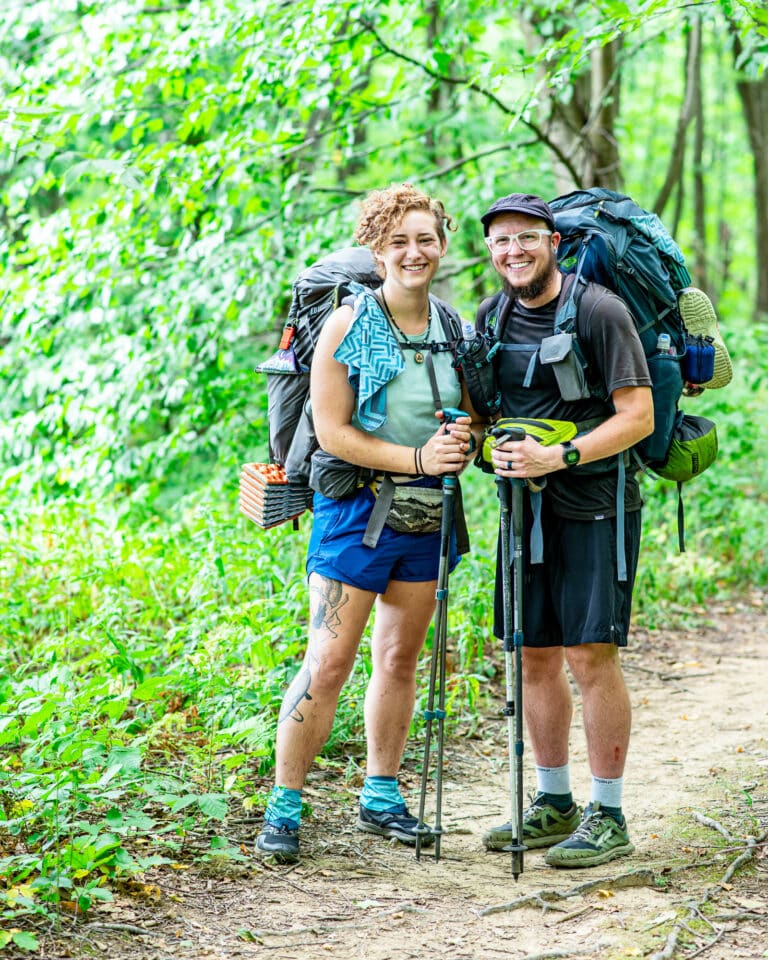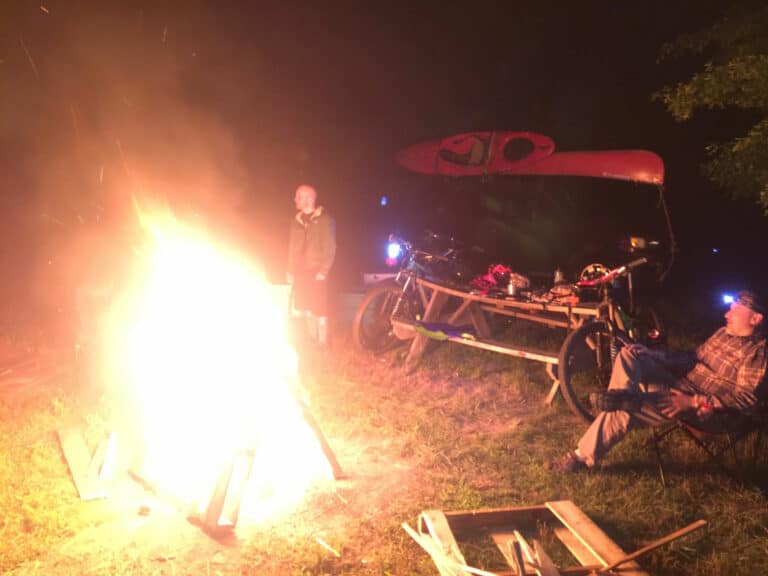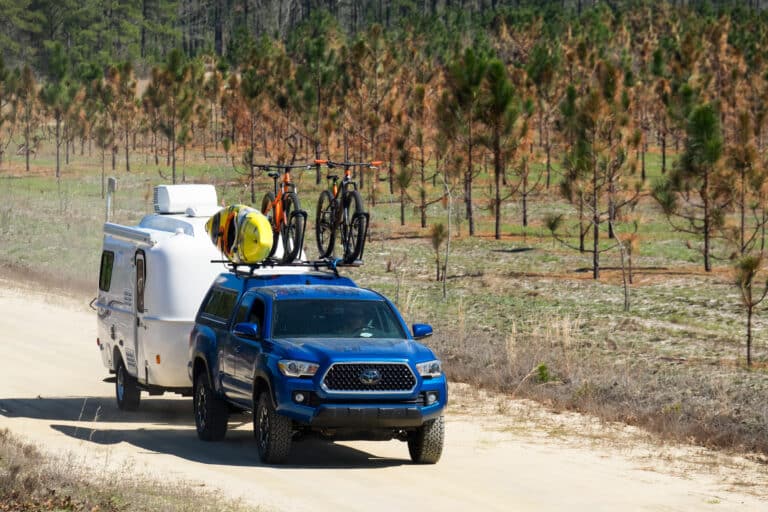At a two-week event in southeast Virginia, women learn professional skills in prescribed fire forest management.
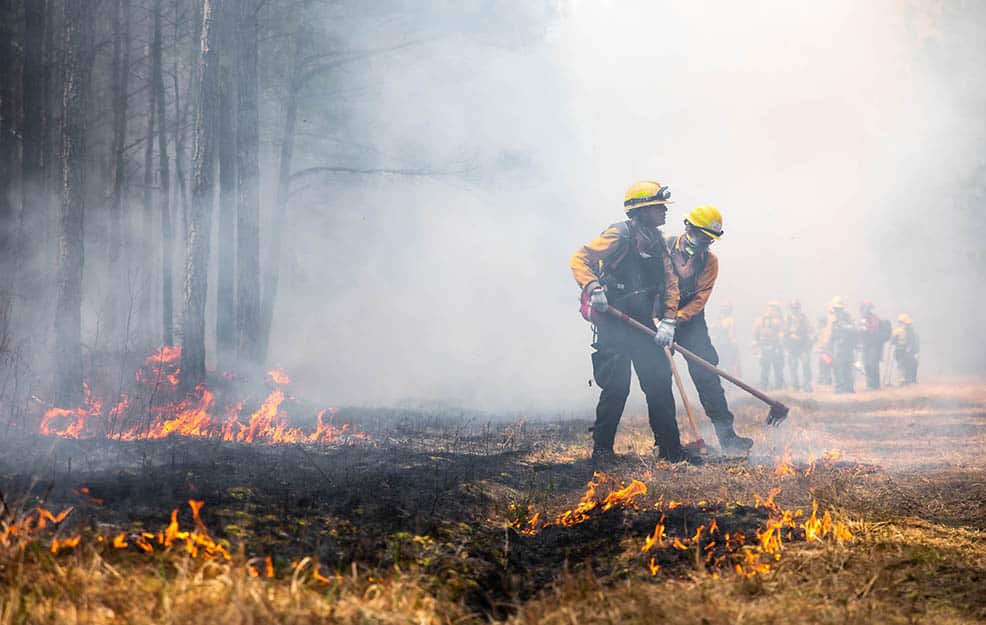
THE FIRST TIME LAUREL SCHABLEIN participated in a prescribed burn felt like a foreign experience as she watched the fire move across the landscape. After years of studying bird communities around Virginia, she knew fire could be used as a tool to create healthier forests but had never seen one up close. “Your heart rate gets up because you’re watching something that we’ve been really conditioned to believe is damaging and harmful,” she said.
That step outside of her comfort zone led Schablein, conservation coordinator with the Nature Conservancy’s Virginia Allegheny Highland Program, into a new stage of her career. At the Warm Springs Mountain Preserve, her team uses prescribed fire to help maintain the biodiversity of the Appalachians. “It’s been a really meaningful way for me to develop a really strong connection with the land,” she said.
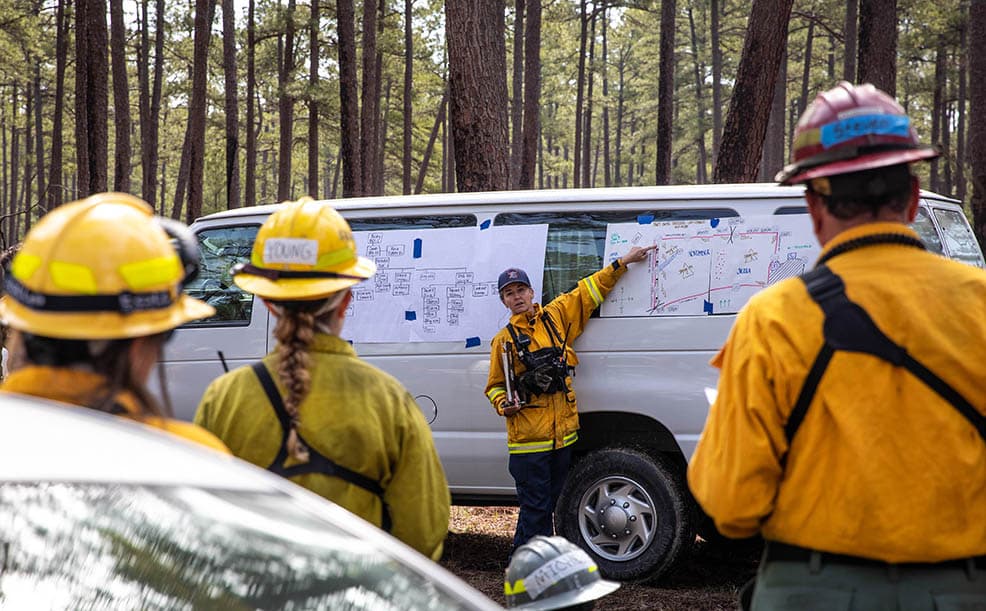
Photo: The burn boss outlines the plan for the day’s burn. Photo by Shannon McGowan
Fire is an important tool in promoting the resiliency of forests, one that was systematically taken off the landscape for decades under a policy of fire suppression. “All of the animals that our forests support evolved with a much more diverse landscape that had a mosaic of all different kinds of conditions,” Schablein said. The homogenization of forests is especially concerning in the face of climate change as the lack of species diversity leads to a higher susceptibility to pathogens and pests.
Just as diversity in forests is important, so is diversity on the fire line. It is not uncommon for Schablein to be the only woman on a burn, especially when it comes to leadership positions. Enter the annual Women-in-Fire Training Exchange (WTREX). Sponsored by a host of partners, including the Nature Conservancy and U.S. Forest Service, the training exchange brings together female fire practitioners from across the world to learn from each other and grow in community.
This spring, 35 participants from 14 states and five countries met in southeastern Virginia for two weeks. BRO caught up with some of this year’s participants to learn what WTREX means to them.
Laurel Schablein, Conservation Coordinator
The Nature Conservancy (Allegheny Highlands, Va.)
This year was Schablein’s third WTREX event. For her, it’s the community of women and the emphasis on learning that keeps her coming back, as trainers make time for dialogue about techniques and mistakes. “We’ve heard the phrase ‘permission to fail’ a lot this week,” she said. “So it’s really putting that in the forefront so that people can step out of their comfort zone, embrace their leadership, and learn here.”
The schedule is packed with workshops, covering topics from fire policy and mapping to imposter syndrome, sexual harassment, and motherhood. When weather conditions allow, attendees work the fire line together, implementing their new skills. “It takes away this idea that you are alone when you have that feeling of not really belonging in a particular male-dominated workforce,” Schablein said. Every day, the participants get to see women calling the shots and modeling a variety of leadership styles.
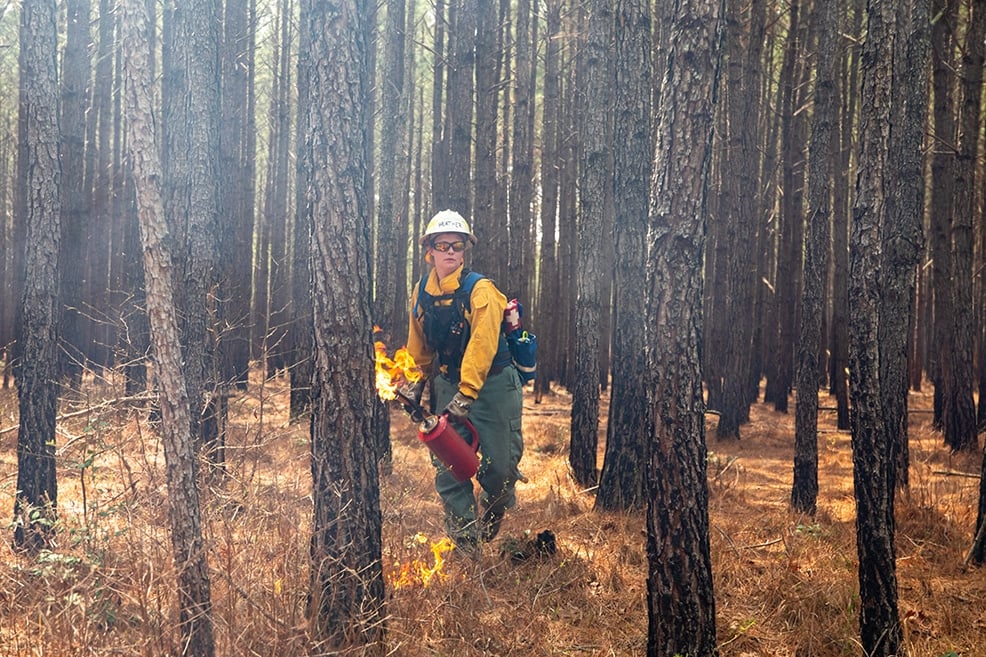
Photo: A participant lights a fire on the Piney Grove Preserve in Southeast Virginia. Photo by Ellen Kanzinger
Lenya Quinn-Davidson, Area Fire Advisor
University of California Cooperative Extension (Humboldt County, Ca.)
According to Lenya Quinn-Davidson, there’s a certain type of magic in bringing these women together. “Many of them have never sat in the same room with 40 other women who work in fire,” Quinn-Davidson said. With that comes a responsibility to create a supportive environment where participants feel safe opening up about their experiences.
For Quinn-Davidson, the WTREX lead organizer, providing a space for mentorship is the key to keeping women in fire. “If they can see someone who looks like them who’s in a leadership position or who’s made it in fire, that gives them the support and vision they need,” she said. In addition to providing participants with hands-on experience, this event is also a chance to build a global network of women in fire to provide support as they move up in their careers.
Why is cultivating gender equity and diversity in the field of fire important? “There’s no future, in Virginia or California, that doesn’t involve fire on the landscape,” Quinn-Davidson said. While fire is an inevitable and natural part of the landscape, wildfire seasons are becoming longer as extended droughts, rising temperatures, and deforestation allow fire to spread faster. According to the U.S. Forest Service, what was once a four-month fire season now lasts between six to eight months in some places.
Prescribed fire is an effective way to conserve and restore habitat. Putting controlled fire on the landscape provides a host of services, from clearing the forest floor of potential fuels to helping fire-adapted species like the longleaf pine thrive in their native habitat. “It’s a real positive, solutions-oriented space in a world that’s fraught with negativity and guilt,” Quinn-Davidson said.
Alicia Rhodenizer, Unit Crew Supervisor
British Columbia Wildfire Service (British Columbia, Canada)
Growing up in British Columbia, Alicia Rhodenizer was exposed to wildfire early on in her life. By the time she was in eighth grade, she knew she wanted to work on the fire line. At the age of 18, she signed up for a summer with the Wildfire Service as one of the only women on the crew. “I was young and maybe a little bit naive,” she said. “Over the years, especially when I started getting into crew leader positions, that’s when I really started to recognize things weren’t all sunshine and rainbows.”
Many things draw Rhodenizer to the world of fire—hard physical work outside, cohesive crew dynamics, and getting to help people on a regular basis. Although the work culture wasn’t always welcoming to women, she’s glad she persevered through the tough times even when she wanted to quit. As she starts her tenth fire season, Rhodenizer found a community of like-minded people at WTREX.
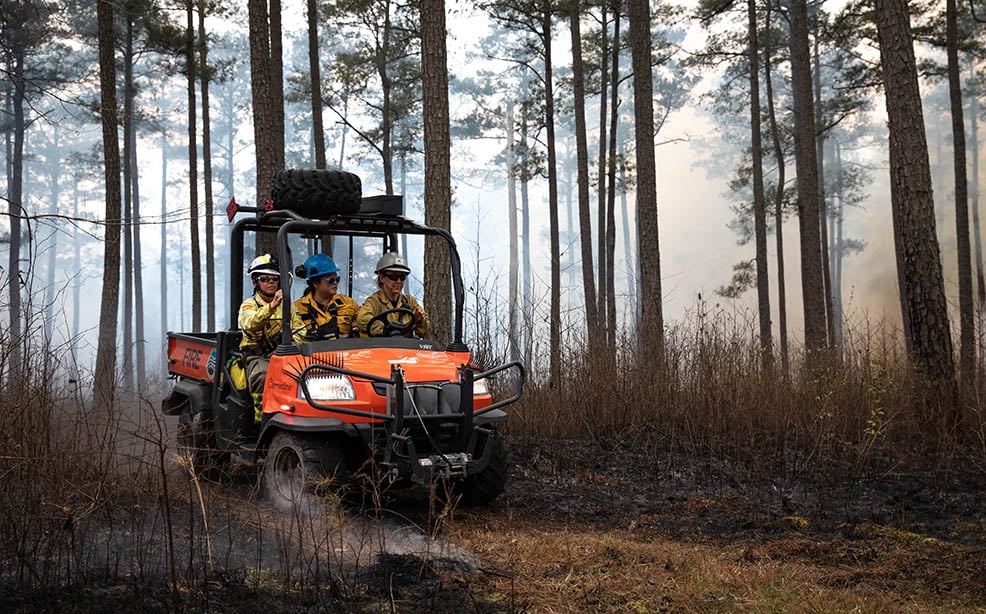
Photo: Kylie Paul, left, Jane Park, and Monique Hein survey the fire. Photo by Shannon McGowan
One of the most beneficial workshops for her was on power dynamics. Participants took turns role playing different scenarios, learning how to respond to a variety of issues that might pop up and talking through strategies to calm things down. “I even got a bit shaky because it felt so realistic to what I experience at work sometimes,” Rhodenizer said. Now that she’s in a leadership position, Rhodenizer does see the field changing as more women pursue a career in fire and discussions around sexist comments, harassment, and diversity are normalized.
Kylie Paul, Superintendent
Juliet Crew (Cape Town, South Africa)
WTREX was just one stop in Kylie Paul’s journey through the U.S., part of a few months spent traveling the country and learning new fire techniques to take back with her to South Africa. As the supervisor of an all-women wildland firefighter crew, Paul knows the importance of common experiences in building trust. “As women, we don’t feel like we can actually make a mistake or fumble, so we won’t take a lot of risks,” she said. “I think we all feel the same that if we get it wrong, it’s representative of all women.”
While Paul mostly works on fire suppression, the lessons learned at WTREX are universal. One of her biggest takeaways was the importance of addressing mental health. Discussions included the importance of incorporating empathy and emotional intelligence into fire, critical to ensuring crew members don’t burn out on the physically and mentally demanding work. “We’re not mechanical,” Paul said. “We’re not machines. We are human beings.”
Nikole Simmons, Restoration Coordinator
The Nature Conservancy (Allegheny Highlands, Va.)
Since the first event in 2016, WTREX has been a space for women to learn and make mistakes in a supportive environment. “Oftentimes I’m the only female in leadership positions on the fire line,” Nikole Simmons said. “Not always, but often.” While mentors of any gender can provide support, training geared specifically towards women offers participants a different perspective in a field where sometimes being the only one can be intimidating.
As a member of the WTREX founding team, Simmons has worked with pioneering women in the world of fire. “Many of them are handing over the reins to us,” she said. “Those are big, important shoes to fill.” Now, she hopes the next generation of women in fire will be able to benefit from all the work it’s taken to get to this point.
Cover Photo: WTREX participants work the fire line. Photo by Shannon McGowan
